Abstract
1. Effects of bepridil on ventricular depolarization and repolarization sequences were examined in rabbit Langendorff-perfused hearts. 2. In distant bipolar electrograms (DBEs), bepridil, 10(-6) M, caused a significant prolongation of QT intervals. At 10(-5) M, the QT prolongation was further enhanced, and a significant prolongation of QRS duration was also observed. Polymorphous ventricular tachycardia was frequently induced by a single premature stimulus at the higher concentration. 3. In epicardial electrograms recorded through modified bipolar electrodes, bepridil, 10(-6) M, prolonged the interval from the peak negative deflection of the QRS complex to the apex of the T wave (Q-aT), which corresponded to the intracellular action potential duration at 90% repolarization (APD90). The Q-aT prolongation was larger in the base than in the apex, resulting in a marked distortion and dispersion of repolarization. The epicardial activation sequence was unaffected. 4. At 10(-5) M bepridil, the dispersion of repolarization was much more enhanced by activation delay in the epicardial surface. 5. These findings suggest that bepridil causes regionally different lengthening of APD in ventricular muscle leading to an increase in temporal dispersion of repolarization, and that this dispersion may be inducive for re-entrant arrhythmias when accompanied by slow conduction at toxic doses.
Full text
PDF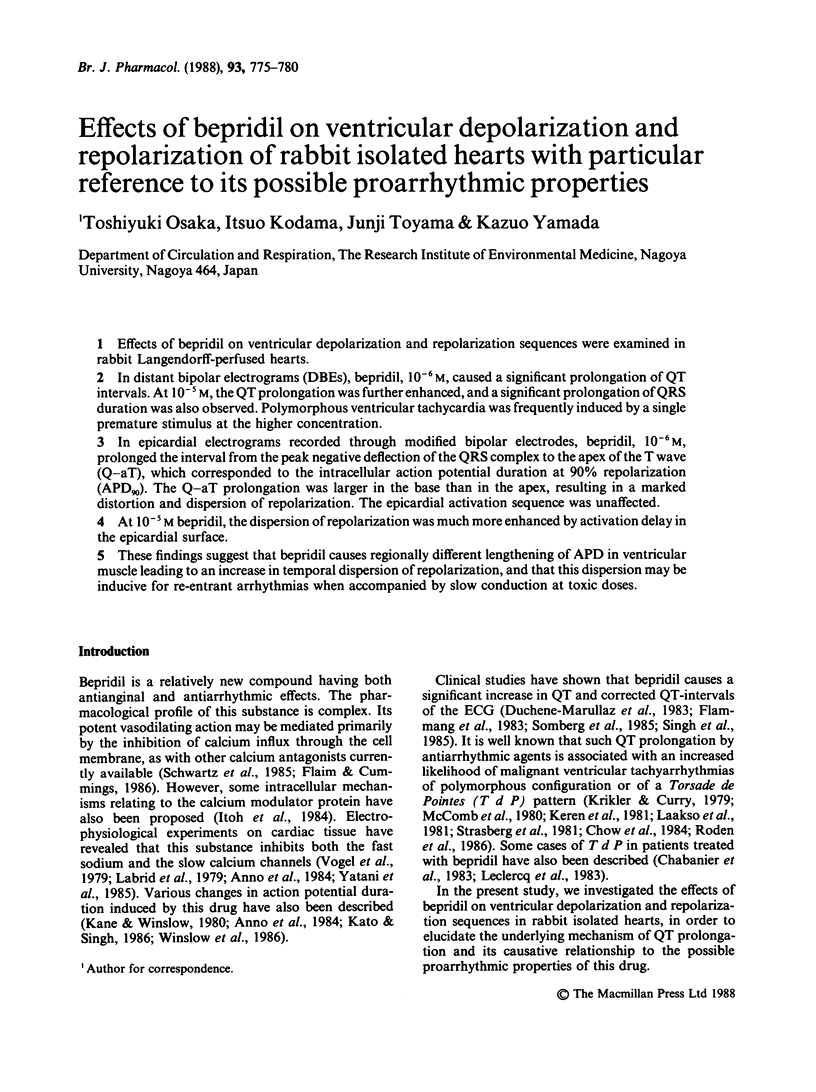

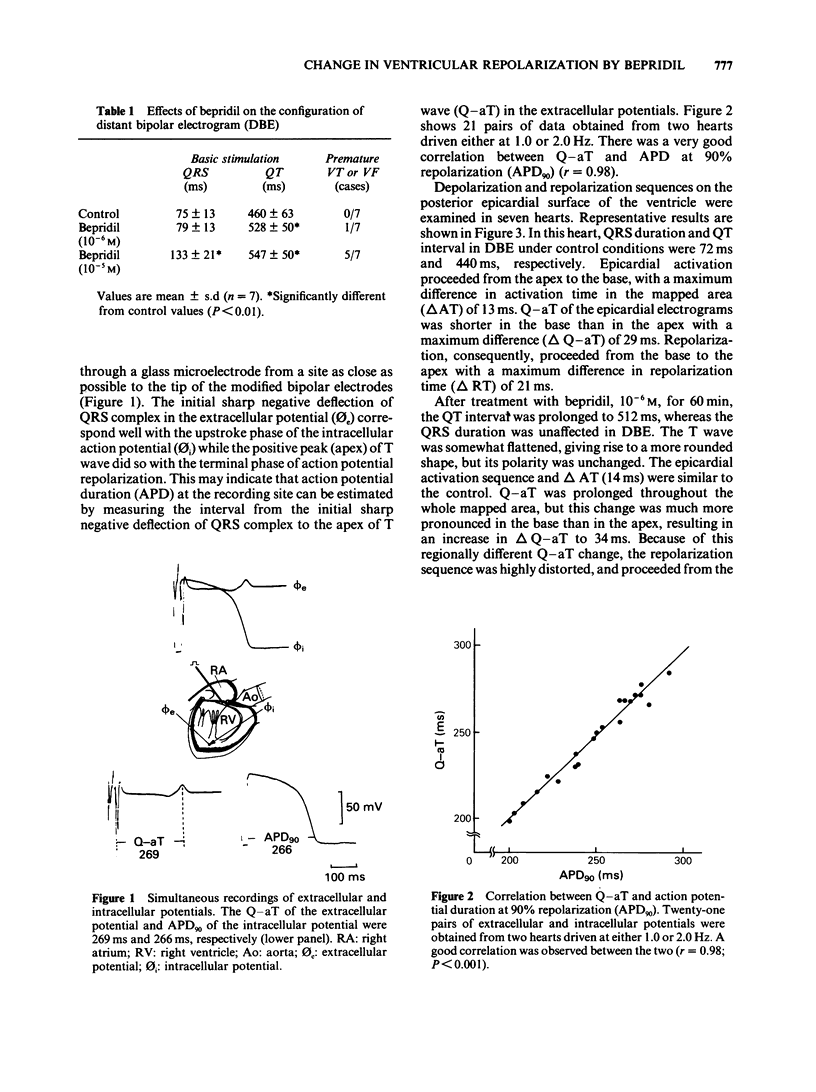
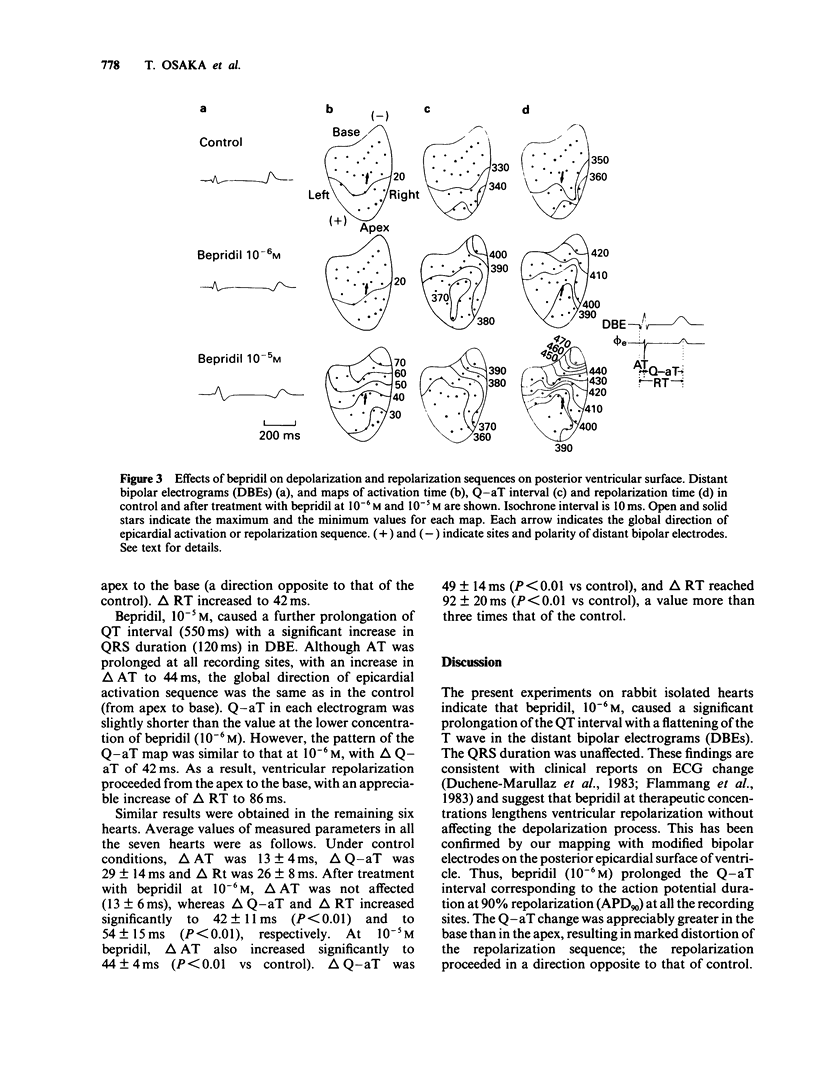
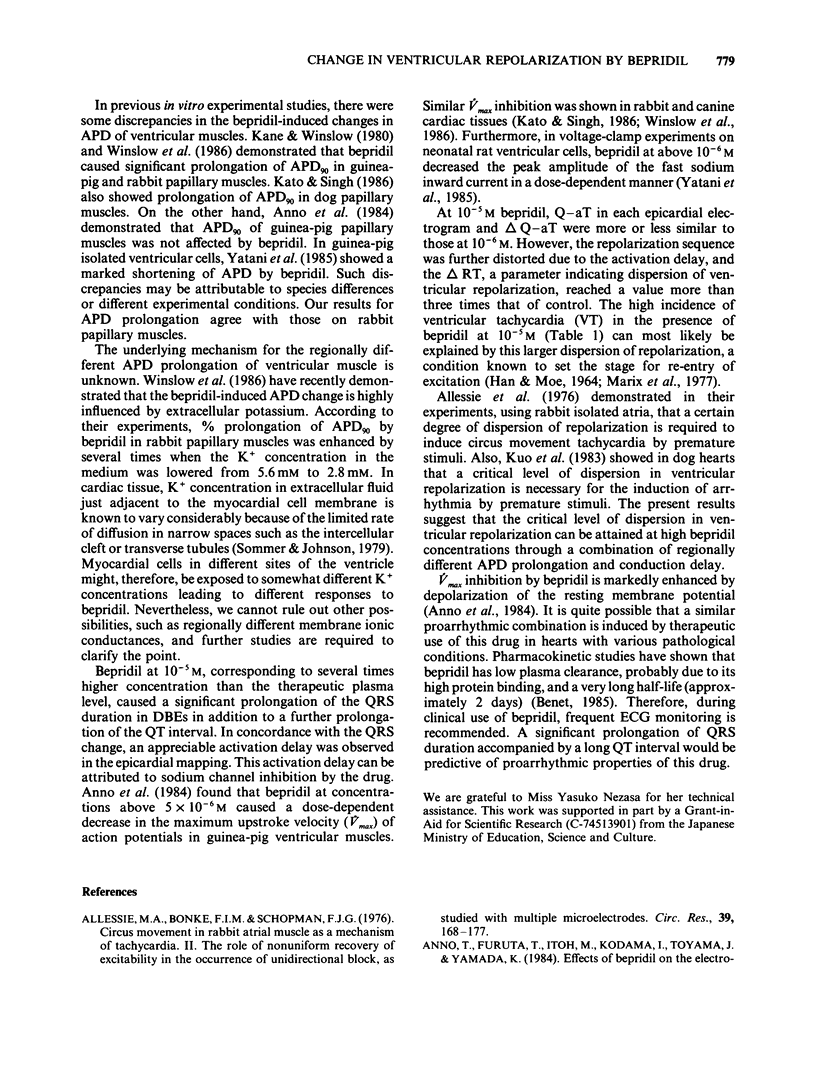
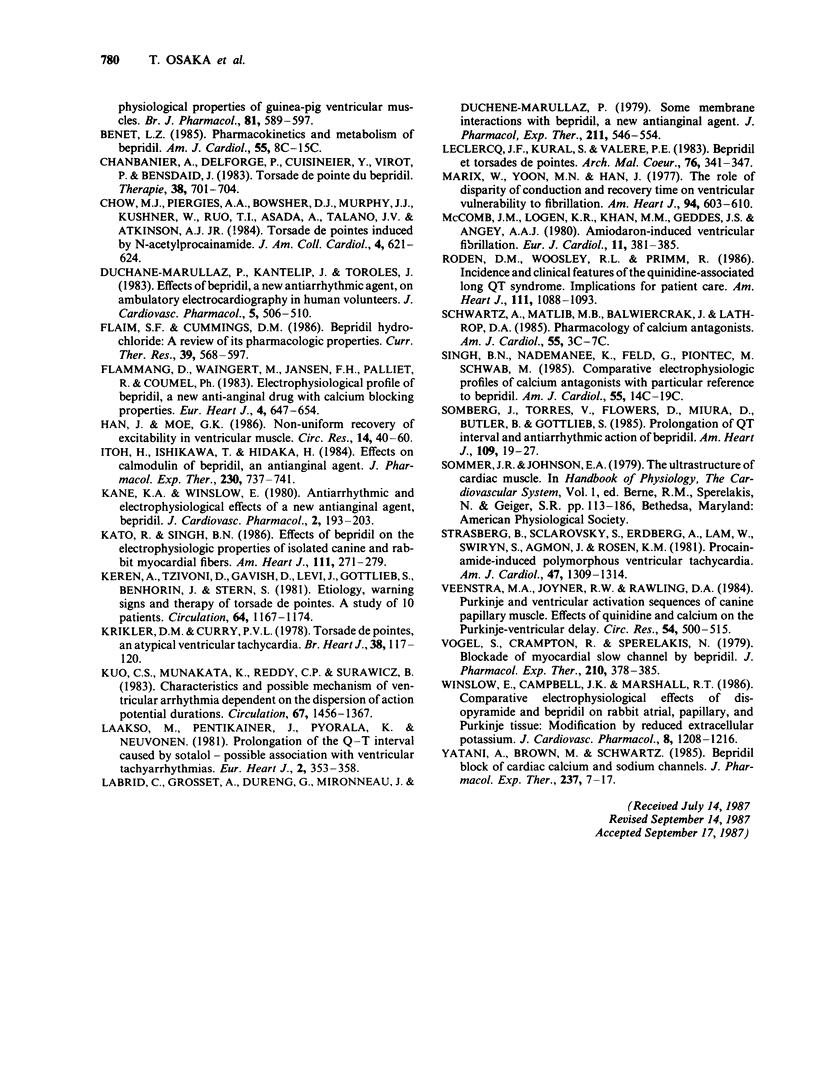
Selected References
These references are in PubMed. This may not be the complete list of references from this article.
- Allessie M. A., Bonke F. I., Schopman F. J. Circus movement in rabbit atrial muscle as a mechanism of tachycardia. II. The role of nonuniform recovery of excitability in the occurrence of unidirectional block, as studied with multiple microelectrodes. Circ Res. 1976 Aug;39(2):168–177. doi: 10.1161/01.res.39.2.168. [DOI] [PubMed] [Google Scholar]
- Anno T., Furuta T., Itho M., Kodama I., Toyama J., Yamada K. Effects of bepridil on the electrophysiological properties of guinea-pig ventricular muscles. Br J Pharmacol. 1984 Apr;81(4):589–597. doi: 10.1111/j.1476-5381.1984.tb16123.x. [DOI] [PMC free article] [PubMed] [Google Scholar]
- Chow M. J., Piergies A. A., Bowsher D. J., Murphy J. J., Kushner W., Ruo T. I., Asada A., Talano J. V., Atkinson A. J., Jr Torsade de pointes induced by N-acetylprocainamide. J Am Coll Cardiol. 1984 Sep;4(3):621–624. doi: 10.1016/s0735-1097(84)80111-4. [DOI] [PubMed] [Google Scholar]
- Duchêne-Marullaz P., Kantelip J. P., Trolèse J. F. Effects of bepridil, a new antianginal agent, on ambulatory electrocardiography in human volunteers. J Cardiovasc Pharmacol. 1983 May-Jun;5(3):506–510. doi: 10.1097/00005344-198305000-00024. [DOI] [PubMed] [Google Scholar]
- Flammang D., Waynberger M., Jansen F. H., Paillet R., Coumel P. Electrophysiological profile of bepridil, a new anti-anginal drug with calcium blocking properties. Eur Heart J. 1983 Sep;4(9):657–654. [PubMed] [Google Scholar]
- HAN J., MOE G. K. NONUNIFORM RECOVERY OF EXCITABILITY IN VENTRICULAR MUSCLE. Circ Res. 1964 Jan;14:44–60. doi: 10.1161/01.res.14.1.44. [DOI] [PubMed] [Google Scholar]
- Itoh H., Ishikawa T., Hidaka H. Effects on calmodulin of bepridil, an antianginal agent. J Pharmacol Exp Ther. 1984 Sep;230(3):737–741. [PubMed] [Google Scholar]
- Kane K. A., Winslow E. Antidysrhythmic and electrophysiological effects of a new antianginal agent, bepridil. J Cardiovasc Pharmacol. 1980;2(2):193–203. doi: 10.1097/00005344-198003000-00010. [DOI] [PubMed] [Google Scholar]
- Kato R., Singh B. N. Effects of bepridil on the electrophysiologic properties of isolated canine and rabbit myocardial fibers. Am Heart J. 1986 Feb;111(2):271–279. doi: 10.1016/0002-8703(86)90139-0. [DOI] [PubMed] [Google Scholar]
- Keren A., Tzivoni D., Gavish D., Levi J., Gottlieb S., Benhorin J., Stern S. Etiology, warning signs and therapy of torsade de pointes. A study of 10 patients. Circulation. 1981 Dec;64(6):1167–1174. doi: 10.1161/01.cir.64.6.1167. [DOI] [PubMed] [Google Scholar]
- Krikler D. M., Curry P. V. Torsade De Pointes, an atypical ventricular tachycardia. Br Heart J. 1976 Feb;38(2):117–120. doi: 10.1136/hrt.38.2.117. [DOI] [PMC free article] [PubMed] [Google Scholar]
- Kuo C. S., Munakata K., Reddy C. P., Surawicz B. Characteristics and possible mechanism of ventricular arrhythmia dependent on the dispersion of action potential durations. Circulation. 1983 Jun;67(6):1356–1367. doi: 10.1161/01.cir.67.6.1356. [DOI] [PubMed] [Google Scholar]
- Laakso M., Pentikäinen P. J., Pyörälä K., Neuvonen P. J. Prolongation of the Q-T interval caused by sotalol--possible association with ventricular tachyarrhythmias. Eur Heart J. 1981 Aug;2(4):353–358. doi: 10.1093/oxfordjournals.eurheartj.a061216. [DOI] [PubMed] [Google Scholar]
- Labrid C., Grosset A., Dureng G., Mironneau J., Duchene-Marullaz P. Some membrane interactions with bepridil, a new antianginal agent. J Pharmacol Exp Ther. 1979 Dec;211(3):546–554. [PubMed] [Google Scholar]
- Leclercq J. F., Kural S., Valère P. E. Bépridil et torsades de pointes. Arch Mal Coeur Vaiss. 1983 Mar;76(3):341–348. [PubMed] [Google Scholar]
- McComb J. M., Logan K. R., Khan M. M., Geddes J. S., Adgey A. A. Amiodarone-induced ventricular fibrillation. Eur J Cardiol. 1980;11(5):381–385. [PubMed] [Google Scholar]
- Merx W., Yoon M. S., Han J. The role of local disparity in conduction and recovery time on ventricular vulnerability to fibrillation. Am Heart J. 1977 Nov;94(5):603–610. doi: 10.1016/s0002-8703(77)80130-0. [DOI] [PubMed] [Google Scholar]
- Roden D. M., Woosley R. L., Primm R. K. Incidence and clinical features of the quinidine-associated long QT syndrome: implications for patient care. Am Heart J. 1986 Jun;111(6):1088–1093. doi: 10.1016/0002-8703(86)90010-4. [DOI] [PubMed] [Google Scholar]
- Singh B. N., Nademanee K., Feld G., Piontek M., Schwab M. Comparative electrophysiologic profiles of calcium antagonists with particular reference to bepridil. Am J Cardiol. 1985 Mar 15;55(7):14C–19C. doi: 10.1016/0002-9149(85)90800-8. [DOI] [PubMed] [Google Scholar]
- Somberg J., Torres V., Flowers D., Miura D., Butler B., Gottlieb S. Prolongation of QT interval and antiarrhythmic action of bepridil. Am Heart J. 1985 Jan;109(1):19–27. doi: 10.1016/0002-8703(85)90410-7. [DOI] [PubMed] [Google Scholar]
- Strasberg B., Sclarovsky S., Erdberg A., Duffy C. E., Lam W., Swiryn S., Agmon J., Rosen K. M. Procainamide-induced polymorphous ventricular tachycardia. Am J Cardiol. 1981 Jun;47(6):1309–1314. doi: 10.1016/0002-9149(81)90264-2. [DOI] [PubMed] [Google Scholar]
- Veenstra R. D., Joyner R. W., Rawling D. A. Purkinje and ventricular activation sequences of canine papillary muscle. Effects of quinidine and calcium on the Purkinje-ventricular conduction delay. Circ Res. 1984 May;54(5):500–515. doi: 10.1161/01.res.54.5.500. [DOI] [PubMed] [Google Scholar]
- Vogel S., Crampton R., Sperelakis N. Blockade of myocardial slow channels by bepridil (CERM-1978). J Pharmacol Exp Ther. 1979 Sep;210(3):378–385. [PubMed] [Google Scholar]
- Winslow E., Campbell J. K., Marshall R. J. Comparative electrophysiological effects of disopyramide and bepridil on rabbit atrial, papillary, and Purkinje tissue: modification by reduced extracellular potassium. J Cardiovasc Pharmacol. 1986 Nov-Dec;8(6):1208–1216. doi: 10.1097/00005344-198611000-00017. [DOI] [PubMed] [Google Scholar]


